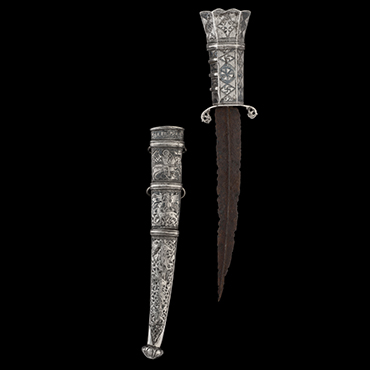Dagger of a Crusader
Inscribed:
Perpetual glory and increasing fortune
This dagger and its scabbard are a product of the Crusades—a period of conflict between Christian and Muslim forces—but it provides clear evidence of the rich artistic exchanges that occurred between the two sides. From its construction and form to its decoration and inscriptions, it exemplifies the porous nature of religious and political boundaries during this time. The dagger is unique as a weapon that combines these opposing influences as part of the initial commission. Its discovery outside the citadel of Acre (Akka) in Palestine—a major Crusader port and administrative center—confirms that it was made during this period.
The use of silver and niello (black paste) and the form of the hilt are associated with Christian craftsmanship. The slight curve of the blade and the dragon-head-shaped quillions that separate the dagger’s blade from its handle, however, reflect an Islamic style.The lower two sections of the scabbard depict hunting animals and scenes of animal combat. The upper middle section illustrates a man on horseback spearing a dragon between his horse’s feet. The mounted dragon-slayer is a figure shared between Christians and Muslims in the medieval eastern Mediterranean, but here he is depicted as a haloed, saintly Christian figure. More distinctively Islamic is the inscription at the top, which employs a phraseology and cursive script associated with objects produced in Syria and adjacent regions during the 6th–7th century AH /12th–13th century CE.
Dagger of a Crusader
Dagger with scabbard
Palestine or Syria, 6th–7th century AH /12th–13th century CE
Silver, niello, steel, l. 38.5 cm
Furusiyya Art Foundation, R-937

